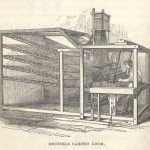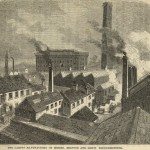Technological Changes: the Brussels Loom
Image: Brussels Carpet Loom. This machine was too large to be used by weavers in their homes. The Useful Arts and Manufacturers of Great Britain of Great Britain Vol. II (London, SPCK, 1846?)
Image from: Science, Technology and Management, Birmingham Central Library
The Brussels loom, which replaced the Scotch loom, was described in 1828 as “the greatest piece of machinery he had ever seen” by John Gast, the London trade unionist. Although he undoubtedly had his own reasons for exaggerating at this time, there is no doubting the complexity of the machine and the dexterity and skill required to operate it. The most concise description of the process comes from somebody who was probably a former weaver.
“The box of bowls was fixed on the top of the loom framing; the tail went from the box horizontally some distance over the right hand of the loom; the neck and harness descended immediately from the box of bowls and the simple cords were attached to the tail cords, just outside the right of the loom, and fastened to the ground at the bottom end. There were 1300 of these simple cords, and it was by grasping with the hand and drawing down selections of them that the desired colours were raised by the neck and harness for producing the pattern”.
« Previous in this sectionNext in this section »Continue browsing this section
 Made in Kidderminster: the History of the Carpet Industry
Made in Kidderminster: the History of the Carpet Industry
 The Origins of Carpet Making in Kidderminster
The Origins of Carpet Making in Kidderminster
 The Origins of Carpet Making in Kidderminster
The Origins of Carpet Making in Kidderminster
 The Origins of Carpet Making in Kidderminster
The Origins of Carpet Making in Kidderminster
 Handloom Weaving
Handloom Weaving
 The Factory System
The Factory System
 Washing and Winding
Washing and Winding
 Washing and Winding
Washing and Winding
 Technological Changes: the Scotch Loom
Technological Changes: the Scotch Loom
 Technological Changes: the Brussels Loom
Technological Changes: the Brussels Loom
 Technological Changes: the Jacquard Loom
Technological Changes: the Jacquard Loom
 The Kidderminster Carpet Industry and the Wider World
The Kidderminster Carpet Industry and the Wider World
 The Kidderminster Carpet Industry and the Wider World
The Kidderminster Carpet Industry and the Wider World
 Working Conditions in Kidderminster Carpet Factories
Working Conditions in Kidderminster Carpet Factories
 The Great Strike of 1828
The Great Strike of 1828
 The Aftermath of the Great Strike of 1828
The Aftermath of the Great Strike of 1828
 Kidderminster in the mid 19th Century
Kidderminster in the mid 19th Century
 Kidderminster: the Factory Town
Kidderminster: the Factory Town






